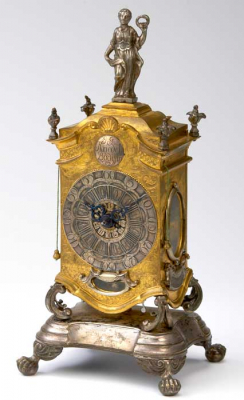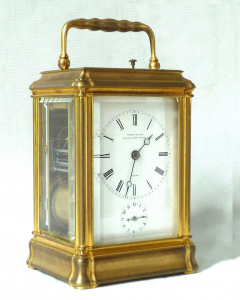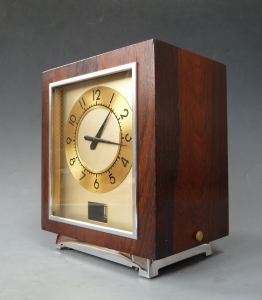A German rococo mid 18th century travelling clock on a terrace by Kriedel Budissin, 1749.
A German, mid eighteenth-century travelling clock on a terrace, signed and dated on the backplate Kriedel Budissin, 1749. The rococo case is made of gilt and silvered brass, the front with a lavishly engraved Flemish gable with rocaille decorations. The silver champlevé dial on an engraved gilt plate, silver-framed pendulum aperture beneath the dial ring. A silver circular signature cartouche in the moulded arch: J.G. Kriedel Budissin. The sides have framed windows to view the movement, the back is provided with a door, which holds two bells in bell straps and is hinged at the bottom. The case is surmounted by silver finials on the corners and a figure of a woman holding an *Ouroboros. The whole stands on scroll feet on the terrace, while the terrace itself has claw-on-ball feet. Movement: The spring-driven, day-going movement has going and striking work, and alarm, the going train with verge escapement, hair-spring balance and chain fusee. The quarter-hour striking work indicates the hours and quarters on two bells with three engraved hammers. It can be repeated on request by pulling a cord. To wind the alarm another string has to be pulled, the time being set at will by an alarm disc behind the pierced blued-steel hands and indicated by the tail of the hour hand. Dimensions: height: 25.5 cm, depth: , width: . Price € 14.750,-- Literature: Jurgen Abeler, "Meister der Uhrmacherkunst" on page 365.
- Reference:
- 100-342
Contact
Van Dreven Antiquair
Fred van Dreven
Prinsengracht 483, 1016 HP Amsterdam, The Netherlands
E-mail: dreven@xs4all.nl
Mobile: +31 (0)6 536 434 43
View in person?
Visit showroom, by appointment.









